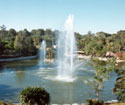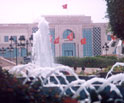|
|
الإستقبال : Presentation Tunis, the green city Tunis, the green city
|
|
|
|
|
| Tunis, the green city |
 |
The capital of Tunisia has 1000 hectares of green spaces of which 110 hectares reserved for the Park of the Belvedere with 30.000 standing trees, for the big happiness inhabitants is doubled by a zoo on a surface of 13 hectares, with 1000 animals belonging...
|
| |
|
Tunis, the green city |
 The capital of Tunisia has 1000 hectares of green spaces of which 110 are hectares reserved for the Park of the Belvedere with 30.000 standing trees, for the big happiness of his(her) inhabitants is doubled by a zoo on a surface of 13 hectares, with 1000 animals belonging to 115 sorts draining the number of visitors to exceeding 800.000 every year. |
|
An administrative, commercial and economic pole
|
|

Ministries, primary, secondary and superior establishments of education, the establishments of public health as well as banks, agencies of insurances and receipts of the finances workbenches in Tunis, constitute the biggest administrative pole of the Tunisian Republic.
Besides this important administrative presence, hundreds of shops, about ten hypermarkets, several shopping malls and a multitude of stores animate the commercial activity in Tunis.
The industrial activity of the capital is unique on the scale of the country: all the branches are represented (cement works, fertilizer, metal industry, textile, food-processing industry). Tunis also occupies a considerable place in the international trades.
Supporting this administrative, economic and commercial presence, drunk networks and shod extend respectively over 5836 km and 82 km. The Tunisian Company of Transport ( STT) gives to the citizen 186 lines drunk, 5 lines subway and 1 line shod by suburb ( TGM).
|
|
Municipality of Tunis |
 The City hall of Tunis was build in August 30th, 1858. It is the most ancient city hall of Tunisia. His 1st Mayor was the General Hussein ( 1858-1865 ). The City hall of Tunis was build in August 30th, 1858. It is the most ancient city hall of Tunisia. His 1st Mayor was the General Hussein ( 1858-1865 ).
More and more active in the socioeconomic and cultural fiels, the City hall of Tunis received several international distinctions among which " The Prize Aga Khan of architecture in 1983 and 1995, in recognition of the contribution of the project Hafsia in the preservation of the Arabian-Moslem architecture and " the UNESCO Prize of Cities for the Peace ", on March 31st, 1998, in recognition of its remarkable contribution to the cause of the right, to the hope, to the solidarity of nearness and to the culture of the peace practiced in everyday life.
|
|
|
|
The aga khan prize of architecture |
The UNESCO prize | |
<< Last page
| |
|
|
|